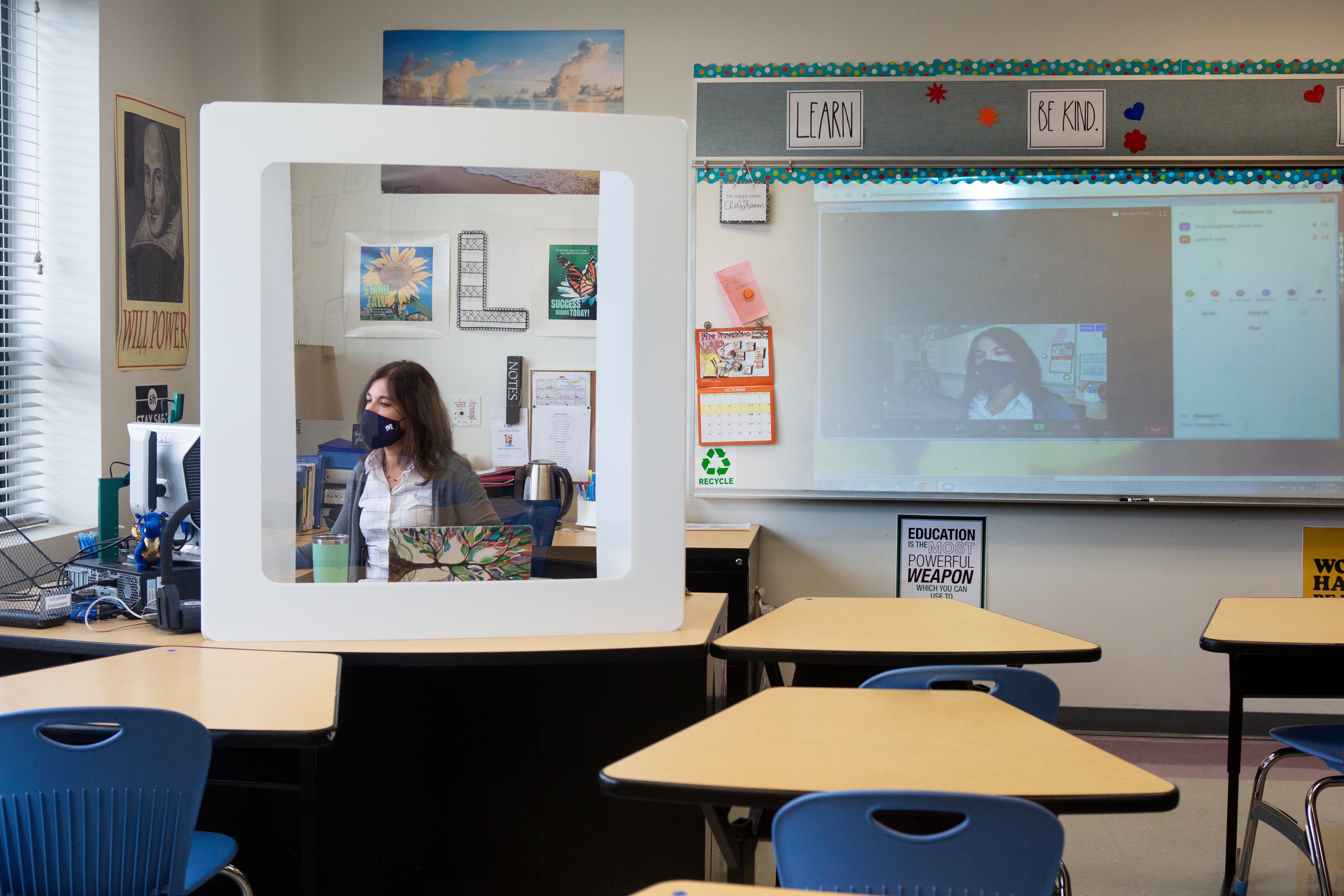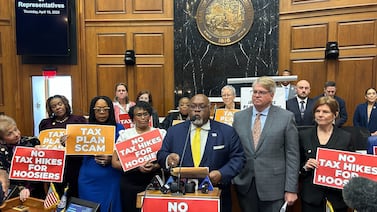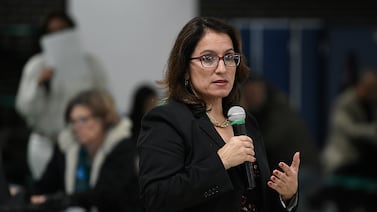As Nick Altman heads back to school, he’s trying to think of the year ahead as a regular year.
A radio and TV teacher at Huntington North High School just outside Fort Wayne, Indiana, Altman is learning students’ names and getting settled in. Hopefully, he said, “We can just move forward.”
In the back of his mind, though, concern lingers. Last year, “There was some excitement going into the school year that maybe, ‘Hey! This could be a normal year,’ and then shortly after we got in, there were quite a few COVID infections, even amongst staff. And it kind of took the wind out of our sails,” Altman recalled.
“I’m feeling more confident that this year will be a little bit more normal, but there is a degree of cautious optimism.”
After years of exhaustion and disruption thanks to the pandemic, many educators like Altman say they’re going into this year with a little hope.
In many parts of the U.S., school will work differently than it has since COVID arrived. Few districts are enforcing a mask mandate, and recently updated federal guidelines did away with the quarantine recommendations that led to cascading student and staff absences. At many schools, there’s a new emphasis on rebuilding a sense of community.
Some educators say that after so much struggle, this year has to be different.
But having experienced whiplash from earlier changes to COVID protocols, and the letdown of last year’s hopes for a comeback, many are still cautious. COVID is still around, and so are many of the other challenges facing educators and their students.
“Last spring, because [schools] got to do prom and graduations and field days and things like that, we’re hearing a lot of hope,” said Amy Lopez, assistant professor of psychiatry at Colorado University and director of Colorado Educator Support. Still, she said, “I think there’s a lot of hopelessness about the profession as a whole.”
Big and small changes
Some educators are trying to step into this school year focusing on the little joys.
Aaron Grossman, a fifth grade teacher at George Westergard Elementary School in Reno, Nevada, anticipates a good school year ahead. He said subtle changes are giving him hope.
“Teaching through a mask, when you’re trying to project like that throughout the school day — it’s hard. I mean, it quite literally is physically taxing. So I don’t have to do that this year,” Grossman said. “You realize, oh, this begins to feel like several years ago.”
“Some of the things I’m hearing are excitement to head back into the classroom, some of the normalcy of getting to know a new batch of kids.”
Aaron Griffin, a middle school principal in Frenchtown, a small community just outside of Missoula, Montana, echoed those thoughts.
“Last year, when we had our first school dance after three years of not having a school dance, I think the teachers were more excited than the students,” Griffin said. “To have our students be able to go to the state science fair, to participate in the live spelling bee instead of the virtual spelling bee, I think that’s the kind of stuff that our communities in Montana really crave.”
Other educators are planning bigger shifts to how their classrooms or schools work — often, efforts to head off some of the behavior challenges schools faced last year or to respond to them differently.
Lopez talks to educators across Colorado when providing mental telehealth support services. Some teachers have told her they are using last year as a learning opportunity and may change how they approach their classes this year to put more emphasis on structure and personal relationships.
Anthony Perdue, a 12th grade African American and Latinx history teacher at KIPP Collegiate Academy in Newark, New Jersey, is seeing that kind of change at their school as detention is being restructured to prompt students to talk about what led them there in restorative justice circles.
“Honestly, I think that will be a really transformative space, just because there was so much negative behavior from the kids last year. But that negative behavior was a direct result of not being able to process a lot of the crazy things and trauma that they were experiencing under COVID,” they said. “I think that is a huge change and a big step in the right direction.”
Staff shortages still straining teachers
Some key issues that have been plaguing teachers throughout the pandemic remain. Filling positions, from bus drivers to special education staff to traditional classroom teachers, has remained a challenge for schools headed into the year. And when positions don’t get filled, that can mean larger class sizes or added responsibilities for teachers.
“As excited as I am to go back and teach, I’m anxious and a little nervous about what environment I’ll be stepping into,” said Nicholas Ferroni, a high school history teacher in New Jersey.
Last year, Ferroni was slated to teach six classes, but when another educator left Union High School mid-year, Ferroni had to take on a seventh class.
“Obviously we all want to help out,” Ferroni said. “But it definitely added an extra stress to the already existing workload that we have.”
In a RAND corporation survey given in January, staffing issues and the extra work taken on when a gap isn’t filled came in as the number one stressor for principals and the number three stressor for teachers. A different RAND survey showed that about 90% of school districts had to change how they operated in one or more schools at some point last year because they were short-staffed.
Quarantine changes and a summer staffing push are likely to help, and evidence of an unprecedented nationwide teacher shortage is thin. Still, the hiring challenges are real.
“For the start of the year, I told my staff we will probably have zero paraprofessionals,” said Griffin, in Montana.
More than 80% of school leaders reported concerns about teacher mental health in a more recent federal survey, and nearly 45% of principals listed supporting teachers’ and staff members’ mental health and well-being as a top stressor, according to RAND surveys. As mental health issues in schools get more visibility, teachers say they or their peers are sometimes struggling without support.
“If our students are our future, we’re in trouble, because our teachers are tired,” said Sonya Battle, founder of The Teacher’s Resource, a nonprofit educator support group.
As of May, only about 14% of schools said they directly provided staff mental health counseling. Another 39% reported that they made referrals outside the school.
Grossman said at his school teachers have been implementing mindfulness practices like “bear breaths” not just for their students but for themselves.
“We explain what a bear breath is, letting kids understand this is part of self regulation, that there are going to be moments of real anxiety,” he said. “People are trying to sort of incorporate those own outcomes in their lives, not just bring them to their kids.”
Navigating curriculum changes
The tensions surrounding curriculum choices are also a weight on some educators’ shoulders as they head into the new year.
Kathryn Vaughn is an elementary art teacher in rural southwestern Tennessee, where debates about critical race theory, and how to teach about racism and sexism, gained national attention and were a key topic of local discourse last year. She’s also the president of her local chapter of the Tennessee Education Association, and curriculum changes designed to add books with stories by people of color earlier in the pandemic prompted a wave of online harassment that shook her.
“It’s been a very tumultuous time to be a teacher,” she said. “I’m someone that’s worked here in this county for almost 20 years, I’ve dedicated my life to the success of children here, and so when people tell me, I’m stupid and don’t know anything, or call me a Marxist for being an educator, it’s incredibly hurtful.”
Over 60% of principals and nearly 40% of teachers reported being harassed because of their school’s policies on COVID-19 safety measures or for teaching about race, racism, or bias during the first half of the 2021-22 school year, according to RAND.
This year, Vaughn expects to hear more feedback about curriculum choices, but feels more prepared than in previous years. Her superintendent sent out an email voicing support for teachers, she said.
At KIPP Collegiate Academy in Newark, the school made changes to its history curriculum over the summer to focus more on the experiences of Black and Latino Americans. Perdue expects parents and educators to question and debate those changes, and will welcome that discussion.
“I think whenever you have a huge change like that, people are going to be resistant to it, because it is just a change from the norm,” they said. “It is different than what they’ve done before.”
Alex Magaña, executive director of the Beacon Network Schools in Denver, said that even with the challenges schools are facing, this year is a chance for educators to “reset.”
He’s thinking about ways to build trust among teachers, celebrate students, and return to even more of the school’s pre-pandemic procedures.
“I am very optimistic for this school year, going back to what we love and why we got into this profession,” Magaña said. “But I’m also pushing that we challenge the status quo. That means, how do we meet the needs of kids where they’re at?”
Jessica Blake is a summer reporting intern for the Chalkbeat national desk. Contact her at jblake@chalkbeat.org or on Twitter at @JessicaEBlake.





